One kilometer off the Philippine island of Palawan lies the Rasa Island Wildlife Sanctuary; here forest grows unimpeded from a coral island surrounded by mangroves and coral reefs. Although tiny, over a hundred bird species have been recorded on the island along with a major population of large flying foxes, while in the waters below swim at least 130 species of coral fish, three types of marine turtles, and that curious-looking marine mammal, dugongs. Most importantly, perhaps, the island is home to the world’s largest population of Philippine cockatoos (Cacatua haematuropygia), currently listed as Critically Endangered. But, although uninhabited by people, Rasa Island may soon be altered irrevocably by human impacts. Officials have proposed to build a coal-fired power plant directly across the strait on the mainland of Palawan with its ‘stack shadow’ (the radius surrounding a coal plant of 0.8-1.6 kilometers) reaching all the way to Rasa Island Wildlife Sanctuary. But the coal plant’s impacts, in a nation blasted by worsening typhoons, could stretch even further.
Biggest threat to the Philippine cockatoo

Philippine cockatoos. Photo courtesy of Katala Foundation.
The population of Philippine cockatoos on Rasa Island is booming. With the help of conservationists the population has gone from 25 individuals in 1998 to 250 today, representing a quarter of the world’s total population (approximately 1,000 birds). More importantly, it is the only population that appears to be thriving. But conservationists say a 15-megawatt coal power plant by DMCI Power Corporation could change all this.
“The proposed power plant has the potential to advance as the single-most [important threat to] the survival of the critically endangered species as a whole,” reads a position paper on the proposal by the Katala Foundation; Katala is the local name for the Philippine cockatoo.
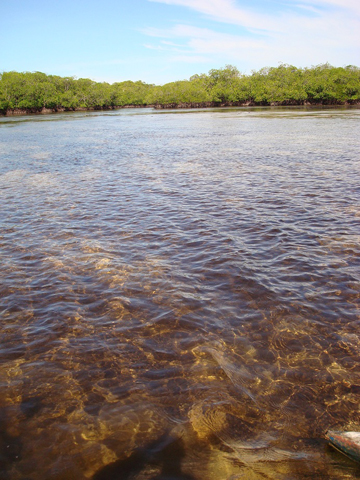 The uninhabited Rasa Island Wildlife Sanctuary is a treasure trove of rare wildlife. Photo by: Peter Widmann. |
The stunning Katala, only found in the Philippines, is dressed in beautiful white feathers and sports a large curving beak. The species is easily-identified by red feathers on the underside of its tail, giving it an additional name, the red-vented cockatoo. As members of the parrot family, cockatoos are generally social and quite vocal.
Conservationists warn that the construction of the coal plant would lead to higher mortality rates for Philippine cockatoos due to collisions and electrocutions on power lines. Other birds, and even large flying foxes, are also expected to be impacted.
“Even more worrying is that the power plant would disrupt the flight path of the cockatoos from the mainland back to the island,” Peter Widmann the Vice President of the Katala Foundation told mongabay.com. Infrastructure and power lines would cut-off the birds’ route to the mainland during breeding season when parent birds are busy collecting food for chicks. Less food would mean fewer babies surviving to adulthood, eventually resulting in a wholesale decline in the island’s cockatoo population.
Philippine cockatoos are already struggling against on-going deforestation of lowland rainforests and the illegal pet trade, whereby chicks are stolen from nests. Now, experts fear the coal plant could offset the best hope for the birds so far: the rising population on Rasa Island.
“The most urgent recommendation is the search for an alternative site,” Widmann says. “The location—so close to an ecologically sensitive area and human settlements—would be unacceptable, even if less polluting fuels for energy generation would be utilized.”
The town of Narra is currently known as the Philippine Cockatoo Capital of the World, but that moniker may change if a the coal plant is built.
Coal, people, and climate
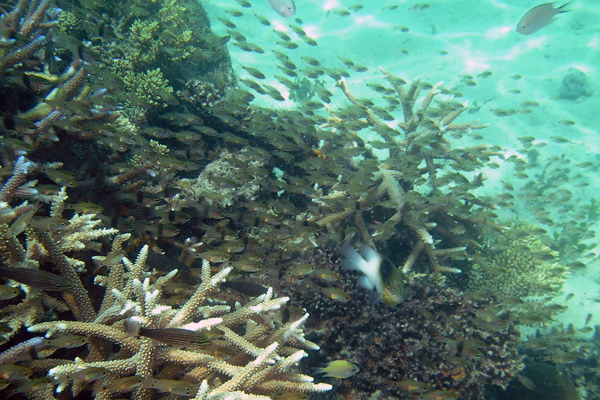
Coral reef off Narra. Photo courtesy of Katala Foundation.
The impacts of a coal plant in Narra would extend well-beyond the Philippine cockatoo: local people and even the Philippines as a whole could be affected.
“The majority of the local population is worried about the plans. They particularly are afraid of negative health effects caused by the burning of coal,” Widmann told mongabay.com.
Burning coal emits a wide-variety of toxic compounds into the environment such as mercury, arsenic, beryllium, cadmium, lead and chromite. Local health impacts are well-documented, including respiratory and cardiovascular disease, as well as trachea, bronchitis, and lung cancer. In 2008, the World Health Organization (WHO) estimated that burning coal leads to a million premature deaths every year worldwide.
In addition, mercury pollution from coal-fired power plants stays in the environment, moving upwards through the food chain.
 Rasa Island Wildlife Sanctuary is home to a large colony of large flying fox (Pteropus vampyrus), which are currently listed as Near Threatened by the IUCN Red List. Photo by: Katala Foundation. |
“This aspect of pollution is particularly relevant for Palawan, where a high proportion of animal protein for human nutrition is derived from fish and other seafood,” reads the position paper by Katala. “Mercury is long known to accumulate in food chains, particularly marine ones, and can cause severe health problems for humans consuming contaminated sea food.”
The coal-fired power plant will likely degrade the marine waters around Narra even aside from mercury pollution. Discharging chlorine and sulfates directly into the ocean, the coal plant will also raise the local waters’ temperature.
“The power plant would use several thousand cubic meters of sea water per hour for cooling purposes. The water at the outfall would be up to eight degrees centigrade warmer than the ambient sea water. Marine organisms, particularly plankton and coral reefs, which are the basis for most marine food webs, are very susceptible to thermal pollution,” explains Widmann. “Coral bleaching near Rasa was already observed during severe dry seasons. Yet another source of heat would add stress to the ecosystem and could prove to be catastrophic.”
Widmann notes that locals, many of whom make their living from fishing, fear that the coal-powered plant could devastate their livelihoods—and fishing isn’t the only economic activity that could be hampered.
“Rasa Island is among the top-ten birding destinations in the Philippines. Many signatories of the online petition against the coal plant have visited Rasa before and are shocked to hear about the plans,” explains Widmann. “If the project would push through, local tourism certainly would suffer.”
 Philippine cockatoo. Photo by: Peter Widmann. |
Finally, carbon emissions from the coal plant will contribute to global climate change, which has not been kind to the Philippines. This nation of islands has been decimated by unusually large and off-season tropical storms in recent years, including Typhoon Bopha last year which killed over 1,000 people. In 2011, Typhoon Sendong also killed over a thousand people. While the death tolls of these typhoons were likely worsened by widespread deforestation and mining, scientists say global warming is likely increasing the severity of typhoons and hurricanes worldwide.
“Climate change is now a clear and present danger and a national security concern for our country,” Filipino Senator Loren Legarda said following Typhoon Sendong, calling the reduction of disaster risk a “moral responsibility.”
But, according to Peter Widmann, the government, both local and federal, continues to push for coal.
“The local government points out that coal is used all over the world for energy generation,” he says. “The Department of Energy promotes coal despite its known effects on climate change.”
The Philippines is heavily dependent on coal-fired power plants for energy production even though coal is the world’s most carbon-intensive fuel. Currently, the Philippines has nine coal plants producing 4,278 megawatts and recently the nation has approved 16 additional coal plants, including the one in Narra, potentially adding another 4,522 megawatts of coal-powered energy.
In its position paper, the Katala Foundation says that the coal-power plant at Narra will be especially polluting.
“Since low grade coal from Semirara would be used, the impact of the coal plant on man-made climate change would be disproportionately high.”
Alternatives

Philippine cockatoo that was killed by striking a power line. Power lines would increase along their flight path if the coal-fired power plant is built. Photo courtesy of Katala Foundation.
It doesn’t have to be this way, according to Bart Duff, a retired economist from the International Rice Research Institute. While producing briefing paper for the Palawan Chamber of Commerce and Industry on the Narra coal plant, Duff discovered that the Narra coal plant was unessential.
“My calculations indicate the local electric cooperative has greatly overestimated its energy requirements for the next 10 years making the coal plant an expensive and unnecessarily costly addition to the energy mix for Palawan,” Duff told mongabay.com.
Still, even if Palawan decides to boost its energy production, there are alternatives. Governments often dismiss other options based solely on the upfront cost compared to coal, but Duff says even here there is a better option
“There exist more economic options. Particularly the use of mini-hydropower with its very lower rate—Php 6.5896/kw-hr. We have about 60 Gigawatts of hydropower which could be brought online within 2-3 years,” says Duff.
While coal may be cheap upfront, the long-term cost to people and the environment is massive. Such costs, known as “externalities” to economists, are not paid by energy companies, but by society as a whole.
“When we include all the externalities of coal (long-term health, degradation of the environment, and contributions to greenhouse house gas accumulation) in the cost calculations coal isn’t as attractive as perceived,” explains Duff. “Of course, the reality is that the externalities are not included at this point.”
A landmark study in 2011 estimated that coal-fired power plants cost the U.S. $523 billion a year in externalities. Of course, even the addition of such massive externalities doesn’t account for what may happen to Philippine cockatoo’s chances for long-term survival if the Narra coal plant moves ahead as planned.
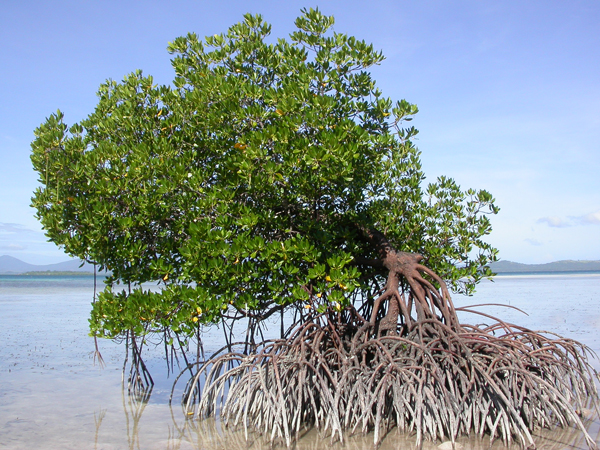
Mangrove off the Rasa Island Wildlife Sanctuary. Photo courtesy of Katala Foundation.

Philippine cockatoo chicks. Photo courtesy of Katala Foundation.
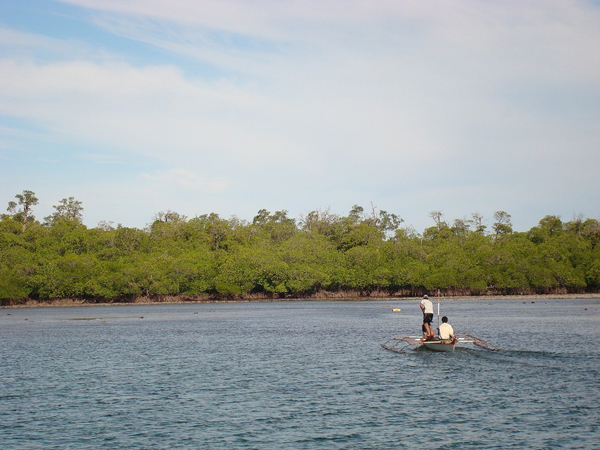
Approaching the Rasa Island Wildlife Sanctuary. Photo courtesy of Katala Foundation.
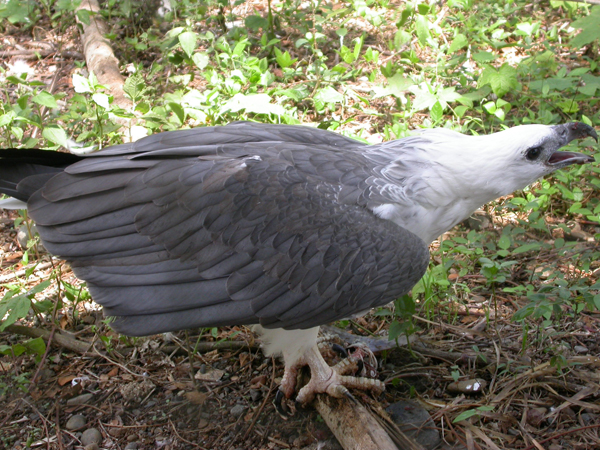
The white-bellied sea eagle (Haliaeetus leucogaster) is found in the sanctuary as well; this species is currently listed as Least Concern, though its population is decreasing. Photo courtesy of Katala Foundation.
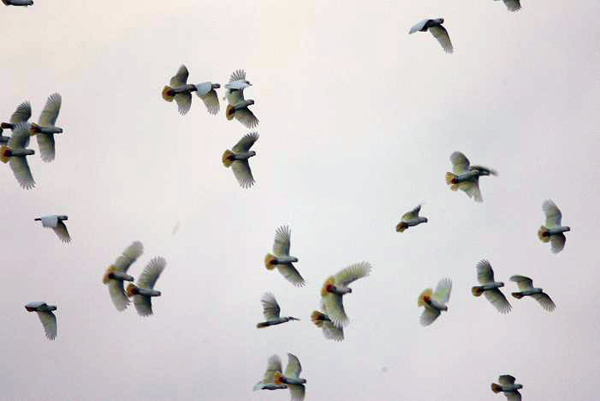
Flock of Philippine cockatoos. Photo courtesy of Katala Foundation.
Related articles
Burning coal may be killing over 100,000 people in India every year

(03/13/2013) India’s dependence on coal-fired power plants for energy may be leading directly to the deaths of 80,000 to 115,000 of its citizens every year, according to the first ever report on the health impacts of coal in the country. The report, commissioned by the Conservation Action Trust and Greenpeace-India, deals only with the direct health impact of coal and not climate change. But even ignoring the rising pain of global warming, the bleak report outlines that coal consumption in India is causing over 20 million asthma attacks, nearly a million emergency room visits, and killing some 10,000 children under five annually.
Nitrogen pollution in China increased 60% annually between 1980 and 2010
(02/25/2013) Nitrogen deposited on land and water in China increased 60 percent annually from the 1980s to the 2000s due to rising use of fertilizer, growth in livestock production, increased coal burning, and a sharp rise in car ownership, reports a study published last week in the journal Nature.
Featured video: moving green, local energy forward in Southeast Asia

(02/25/2013) A new video highlights the work and drive of renewable energy proponents at the inaugural meeting of Southeast Asia Renewable Energy People’s Assembly (SEAREPA) in the Malaysian state of Sabah. Held last year, the meeting brought together 80 organizations from 12 countries to discuss the potential and challenges of green energy in the region. The idea of SEAREPA came about after activists in Sabah successfully defeated plans for a coal-fired power plant to be built adjacent to old-growth rainforest and one of the world’s most biodiverse coral reefs.
New wind power cheaper than coal or gas in Australia
(02/08/2013) Electricity supplied from a new wind farm is cheaper than that from a new gas or coal-fired power plant in Australia, reports a new analysis published by Bloomberg New Energy Finance.
China responsible for 46 percent of global coal consumption
(01/30/2013) A new chart by the U.S. Energy Information Administration shows how China’s coal habit has grown to such an extent that it now accounts for 46.9 percent of the world’s consumption. In 2011 coal consumption hit 3.8 billion tons in China, making up nearly half the world’s coal use of 8.1 billion tons. Coal comes with a number of environmental issues—including toxic air and water pollution—but the most pressing globally is climate change.
Mercury hurts birds and people: what we can learn from studying our feathered friends

(01/07/2013) Birds aren’t that different from people. We learn from our parents, just like zebra finches learn songs from their fathers. We are active and noisy during the day, like birds, and we can also be territorial. Also like birds, we try to attract mates through colorful displays and beautiful songs. Birds are sensitive to pollution in their environment just like we are: harmful elements such as mercury wreak similar havoc on human and bird biology alike. Because our species share so many attributes, studying birds illustrates the connections between them and us.
Wealthy nations’ fossil fuel subsidies dwarf climate financing
(12/05/2012) A new analysis finds that 21 wealthy countries spent five-times more on subsidizing fossil fuels in 2011 than they have on providing funds for poor nations to cut greenhouse gas emissions and adapt to the impacts of climate change. The analysis, by Oil Change International, comes in the midst of the current UN Climate Summit held in Doha, Qatar; progress at the talks has been stymied due to the gulf between poor and rich nations, including on the issue of climate financing.

(12/03/2012) Global carbon dioxide (CO2) emissions from industrial sources are set to hit a new record high this year according to a new analysis by Global Carbon Project. The analysis in Nature Climate Changes predicts that CO2 emissions will rise another 2.6 percent, hitting 35.6 billion tonnes. The scientists warn that such steep climbs in global emissions year-after-year means that the door is rapidly closing on a global agreement to keep temperatures from rising 2 degree Celsius (3.6 degrees Fahrenheit) above pre-industrial levels.
China and India plan 818 new coal plants
(11/26/2012) Even as the clamor to reduce greenhouse gas emissions reaches a new high—echoed recently by such staid institutions as the World Bank and the International Energy Agency (IEA)—a new analysis by the World Resources Institute (WRI) finds that 818 new coal-fired plants are under proposal in China and India. In all 1,199 new coal-fired plants are currently planned worldwide, according to the report, totaling 1.4 million megawatts of energy.
As Doha Climate Summit kicks off, more ambitious cuts to greenhouse gas emissions needed
(11/26/2012) As the 18th meeting of the UN Framework Convention on Climate Change (UNFCCC) kicks off this morning in oil and gas rich Qatar, the world body warns that much more ambitious greenhouse gas cuts are needed to keep catastrophic climate change at bay. A new report by the UN Environment Program (UNEP) and the European Climate Foundation finds that even if all current emissions pledges are kept, the world will still spew 8 billion tonnes of CO2 equivalent above what is needed by 2020, putting the globe on a fast-track to dangerous climate change.
Indian coal giant targets forests
(11/18/2012) The world’s largest coal producer, the state-run Coal India Ltd., plans to massively expand mining in forest areas to help meeting surging demand for electricity, reports The Wall Street Journal.
Micro-hydro and decentralized green energy goals set in Borneo
(11/04/2012) The first ever meeting of the Southeast Asia Renewable Energy People’s Assembly (SEAREPA) ended with agreement on 12 future projects, including developing community micro-hydro power and pushing for new policies on decentralized renewable energy in the region. Held in Malaysian state of Sabah on the island, the meeting brought together 130 people from some 80 different groups.
After defeating coal plant, Borneo hosts renewable energy meeting
(10/31/2012) Last year, a coalition of environmentalists and locals won a David-versus-Goliath battle against a massive coal plant in the Malaysian state of Sabah on Borneo. After facing a protracted campaign—including expert analysis of green energy options for Sabah—the state government announced it was scuttling plans to build the coal plant on a beach overlooking the Coral Triangle. Now, victorious grassroots campaigners are hosting the inaugural meeting of the Southeast Asia Renewable Energy People’s Assembly (SEAREPA), bringing 80 organizations together to discuss green energy options across southeast Asia.














